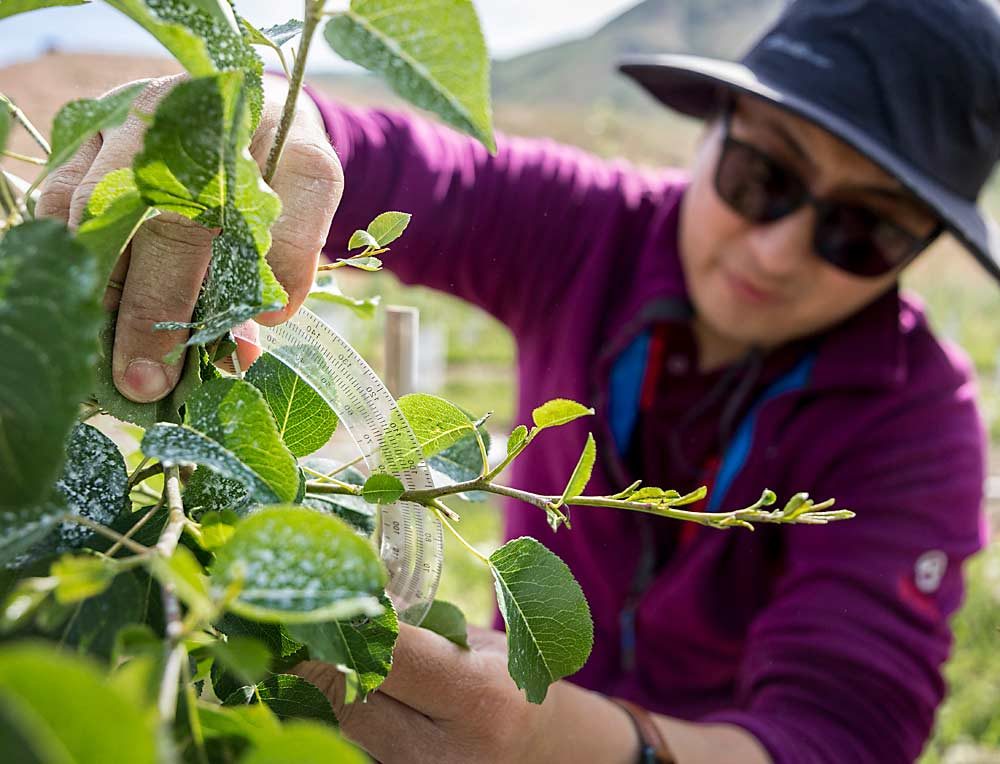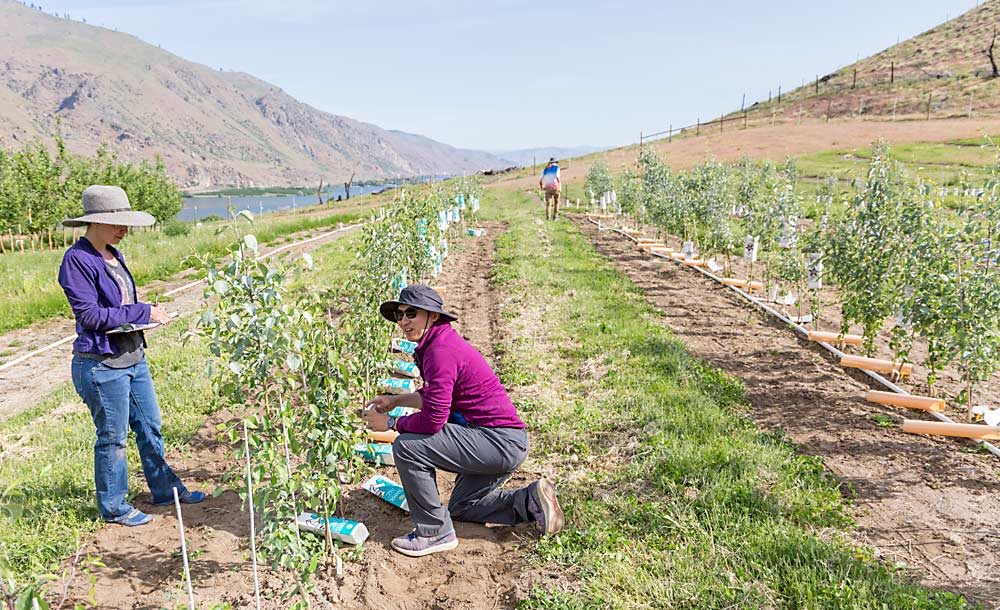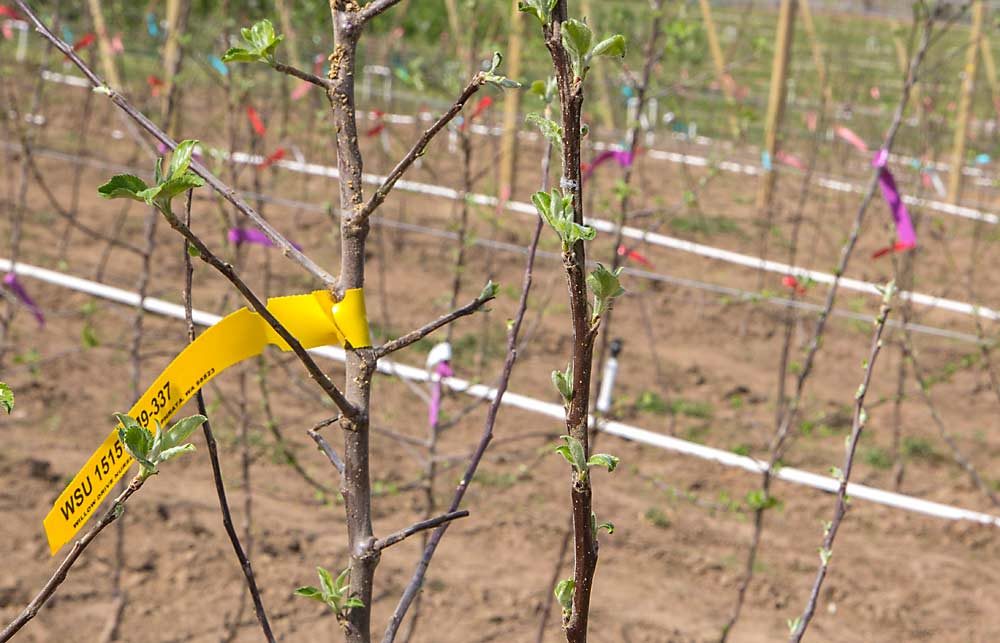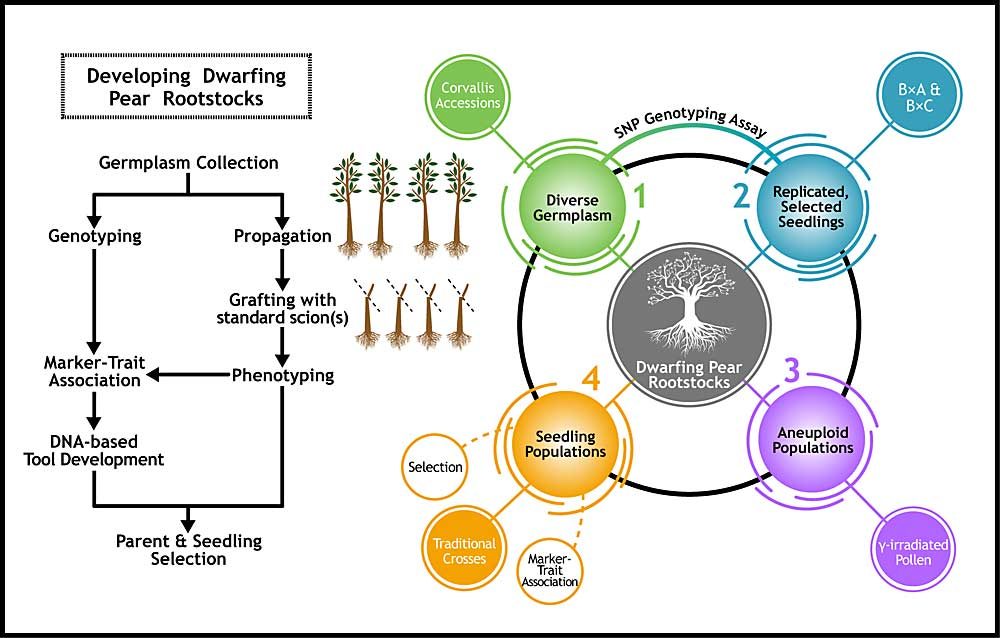
With a clear plastic protractor, Soon Li Teh stoops to measure the branch angle of 600 pear rootstock seedlings at Washington State University’s Columbia View Research Orchard north of Wenatchee. Then, he assesses thorniness the prickly way, by running his palm through the foliage.
Ouch.
Teh’s, well, painstaking data collection is part of the university’s efforts to find dwarfing rootstocks for a struggling pear industry.
Northwest pear groups have pledged support for seven years of projects led by Kate Evans and Amit Dhingra, to the tune of $800,000 through 2021. Their work connects to several efforts in the United States and around the world, as part of the search for the industry’s holy grail.
It’s a tall order for shorter trees — and a long process.
“It’s not fast,” Evans, the WSU pome fruit breeder, told growers at an industry meeting. “I think we’re all aware of that, I hope.”
Evans and Dhingra are part of a wide network with a lengthy history. For decades, the industry has pined for dwarfing rootstocks that may help growers produce pears more efficiently, similar to what the Malling and Geneva series have done for apples.
The first multistate pear rootstock trial was established in 1987 through NC-140, a federally supported project evaluating rootstocks for perennial fruit and nut crops.
Researchers and industry supporters subscribe to the central idea that rootstock studies are a core ingredient for not only smaller trees, but also solving a host of other problems and, ultimately, growers’ overall success.

“There’s really quite a few reasons to do this,” said Bob Gix of Blue Star Growers, co-chair of the research subcommittee of the Fresh Pear Committee, which collectively supports growers in Oregon and Washington under a federal marketing order. In fact, WSU’s work on pear rootstock breeding is one of the reasons the Fresh Pear Committee increased research assessments from 3.1 cents per box to 4.5 cents in 2018, Gix said.
Here are a few examples of how better rootstocks might help:
—WSU researchers have determined fruit quality and maturity varies with canopy location. Dwarfing rootstocks would let growers plant in two-dimensional walls for more uniform quality and ripening.
—A two-dimensional canopy would increase labor efficiency and might eventually enable mechanization.
—Pest control sprays would have better coverage.
—More precocious rootstocks would allow pear trees to reach full production more quickly.
—Dwarfing rootstocks may lead to less cork, a physiological disorder related to excessive vigor pulling nutrients from fruit.
—New rootstocks also may help manage perennial foes fire blight and pear psylla, both of which flourish with vigorous shoot growth.
“There are a lot of huge challenges facing the pear industry and maybe our best chance to address several of those issues is with new genetics,” said Tory Schmidt, project manager for the Washington Tree Fruit Research Commission, which administers the pear research subcommittee grant process.
Gix, Schmidt and others involved with grower-funded research consider rootstock breeding so essential that they scheduled the agenda of the 2019 pear research review in February in Hood River, Oregon, to allow Evans and Dhingra to present a final report and a new proposal simultaneously, almost as a keynote address for the event.
Priority or patience?
Of course, not everyone shares the same priorities.
After decades of looking for rootstocks, Rudy Prey, a Peshastin, Washington, pear grower, would rather groups spend money on building the market, improving infrastructure to deliver ripe pears (see “Pear industry ripe for a rescue”) and combat fire blight.
He envisions a reinvention of the pear industry, similar to that of the avocado. Even if researchers came up with a new rootstock this year, few growers would be able to afford to replant.
He doesn’t want researchers to stop looking for dwarfs, but he doesn’t consider that the highest priority. “All that research, it’s good, but that’s not what is going to save the pear industry at this time.”

Besides, he claims to do just fine without dwarfing rootstocks. He plants pears 2,000 trees to the acre, forcing them, through pruning and competition, to grow in a quasi-two-dimensional, high-yield orchard anyway. “If I can do it, anybody else can do it.”
Evans acknowledged the high price tag and tried to assure growers at the research review that she and Dhingra intend to contain costs.
“I’m not talking about developing a massive project on the scale of RosBREED,” she said. “This is very small-scale.” RosBREED is a federally funded effort to improve fruit production through breeding practices at 22 breeding programs involving 35 scientists at 14 U.S. institutions.
Evans and Dhingra focus on phenotyping, tracking physical characteristics of growth and fruit production from trees actually in the ground. Evans makes crosses, plants seedlings and propagates accessions chosen for their traits. Dhingra speeds up much of the propagation work through tissue cultures and has created some of his own aneuploid dwarf rootstock candidates through mutations introduced by irradiating pollen.
The pair has spent the previous few years collecting rootstock accessions from the U.S. Department of Agriculture National Clonal Germplasm Repository in Corvallis, Oregon, budding them with Anjou scion and replicating them in blocks at Columbia View. They also hired Teh, a postdoctoral researcher who will work almost exclusively on pears.
They have made new crosses, planted more accessions and measured phenotypic traits. Next, they plan to trace dwarfing traits back to genetic markers that other researchers have identified.
Other projects
Though Washington and Oregon produce about 80 percent of America’s pears, Evans and Dhingra fit into a wide national network.
Researchers at the University of California, Davis are doing molecular-level studies, using tiny variations in genetic code, known as single nucleotide polymorphisms, or SNPs, to find desired traits along the now-sequenced pear genome and find redundancy in U.S. collections.
Molecular breeder Sara Montanari recently came up with a list of 500 accessions in the Corvallis collection that may have duplicates. Finding those will prevent redoing expensive research and virus screening on rootstocks that already exist.
Using the high-density SNP genotypic dataset, Montanari also is reconstructing the pedigree of dozens of important pear cultivars, information that will help breeders in their parental selection of rootstocks and varieties alike.
Montanari has recently joined the New Zealand Institute for Plant & Food Research, one of the largest and best-funded players in pome fruit breeding.

Other researchers are looking outside the pear species for help.
Todd Einhorn, a Michigan State University horticulture professor, has rootstock trials using cold-hardy accessions of quince, widely considered a cold-tender relative of pear with dwarfing traits, in Hood River and in Entiat, Washington. He also has been evaluating Amelanchier, or serviceberry, rootstocks for eight years and will begin a new round of trials with improved selections in 2020.
Some of the selections seem to dwarf well, but the goal is to find one or more that will also offer precocity, consistent productivity and good fruit quality, Einhorn said. It’s too soon to recommend any of them to the industry, but he and others plan to keep looking.
“We will focus on the critical balance of vigor and fruiting over many years in order to address potential incompatibility issues,” he said.
Einhorn previously worked for Oregon State University and still receives funding from pear groups in the Northwest. He is collaborating with Stefano Musacchi of Washington State University.
At the USDA Agricultural Research Service in Corvallis, geneticist Nahla Bassil is working on a DNA test to predict fire blight resistance and is using a different type of genetic tracking, simple sequence repeats, SSRs, to fingerprint accessions from the pear collection and confirm Montanari’s duplicates. Other scientists in Corvallis are evaluating accessions or species with useful traits.
Though the work goes on all over the world, the answers to industry questions likely lie somewhere in that Corvallis gene bank, officially named the USDA World Pear Collection, in the repository, said curator Joseph Postman. The facility is home to 2,200 trees representing 1,244 cultivars and 860 wild species from 55 different countries. It also includes 168 rootstock selections.
Researchers sometimes compare a germplasm repository to a pharmacy full of cures, but none of the bottles are labeled. “There are many holy grails buried in our germplasm collections and it just takes a bit of time and effort to find them,” Postman said. •
—by Ross Courtney






Leave A Comment